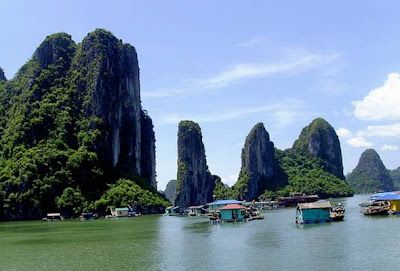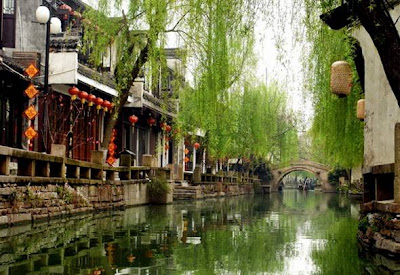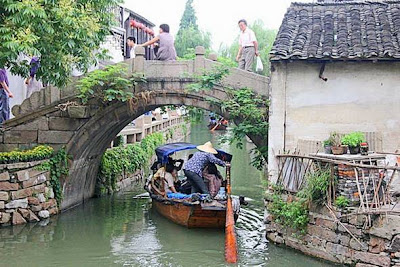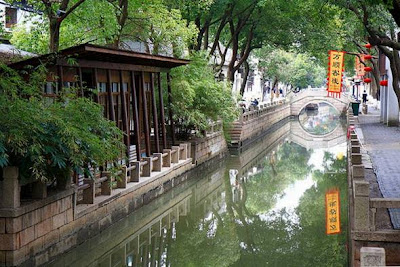Water
villages are settlements that are usually built on the water. Houses
often float on the water or are located on stilts and rarely on small
islands. This is a list of water villages, which are becoming
increasingly popular tourist destinations.
01. Ko Panyi, Thailand
Ko
Panyi is a fishing village in Phang Nga Province, Thailand notable for
being built on stilts by Indonesian fishermen. The population consists
of roughly 200 families or between 1,500 and 2,000 people descended from
2 seafaring Muslim families from Java.

The
village has a Muslim school which is attended by both males and females
in the mornings. Despite the recent rise in tourism, life in Ko Panyi
is still primarily based around the fishing industry as tourists only
visit in significant numbers during the dry season. The village includes
a floating soccer field. Inspired by the 1986 FIFA World Cup, children built the pitch from old scraps of wood and fishing rafts. Google map.
02. Halong Bay Floating Village, Vietnam

A village of about 600 inhabitants built on the water can be found in Halong Bay. It is a magically calm place, an escape
from the hustle of Vietnam streets. The village is a true waterworld,
rising and falling with the tides, sheltered amidst limestone towers.

Locals
live mainly from the sea. Most of the rock islands in the area are too
poor to be cultivated. Halong Bay is very rich in fish and sea food. In this picture you can see some floating houses. Locals live in these houses and every morning they go fishing. They sell their catches to bigger boats, that bring the fresh fish to markets in the continent. Google map.
03. Giethoorn, Netherland

Giethoorn
is a village in the Dutch province of Overijssel. This village is
called the Venice of the Netherlands for about 7.5 km (4.5 mi) of canals
run through the little village. It was founded around 1230 when
fugitives coming from the Mediterranian regions settled there.

All traffic has to go over the water, and it is done in so-called "punters", they are 'whisper-boats' for they are driven by an electric motor, so they practically do not disturb
the peace and quiet in this scenic little village. Many houses have
been built on islands and they can only be reached by the wooden
bridges. Some 50 little wooden bridges span the canals, which are only 1
meter (3 ft) deep. Giethoorn has 2620 inhabitants. Google map.
04. Uros Floating Village, Peru

The
Uros are a pre-Incan people who live on forty-two self-fashioned
floating islands in Lake Titicaca, Peru. These islands are hand-made
from a native species of reed (totora) that abounds in the shallows of
the lake. Uros people build temporary houses that float atop the water
surface. The tide washes over their houses at times, so new layers of
reed need to be laid every 2 weeks for better resistance.

The
larger and most visited islands appear to many travellers as floating
souvenirs, and to some extent these indeed are tourist-traps, their
inhabitants having succeed in living off tourism. However, most of the
smaller islands remain isolated from visitors and still practice a
traditional way of life that includes old-technique fishing,
bird-trapping, and relying on totora for housing and transportation. Google map.
05. Wuzhen, China

Wuzhen
is one of China's ancient water towns, where waterways thread their way
through the flagstone streets and alleys. Covering an area of 71.19
square kilometres (27.49 sq mi), Wuzhen has a total population is 60,000
of which 12,000 are permanent residents.

Wuzhen
displays its two-thousand-year history in its ancient stone bridges
floating on mild water, its stone pathways between the mottled walls and
its delicate wood carvings. Also, setting it apart from other towns, it gives a unique experience through its profound cultural background. Google map.
06. Kampong Ayer, Brunei

Kampong
Ayer is an area of Brunei's capital city Bandar Seri Begawan that is
situated after the Brunei Bay. 39,000 people live in the Water Village.
This represents roughly ten percent of the nation's total population.
All of the Water Village buildings are constructed on stilts above the
Brunei River.
Sultan
Omar Ali Saifuddin Mosque at night (the mosque is built in an
artificial lagoon on the banks of the Brunei River at Kampong Ayer)

Built
on stilts and linked by bridges the water village is also served by
water taxis and has its own schools, hospitals, restaurants, shops,
mosques and petrol station. From a distance, although many of the
dwellings look neglected and run-down, they actually have all the modern
amenities including air conditioning, satellite
television, Internet access, plumbing, and electricity. People have
lived in this village for over 1300 years and some of them keep potted
plants and chickens. Google map.
07. Zhouzhuang, China

Zhouzhuang,
one of the most famous water townships in China, is situated only 30
kilometers southeast of Suzhou City. It is a enchanting place. This
village features crisscrossing water lanes, ancient bridges and
buildings built on and over the rivers. In an area of half a square
kilometer, 60 percent of the Zhouzhuang's structures were built during
the Ming and Qing Dynasties.

It
is noted for its profound cultural background, the well preserved
ancient residential houses, the elegant watery views and the strong
local colored traditions and customs. Zhouzhuang has been called the
"Venice of the East".Google map.
08. Ganvie, Benin

Ganvie,
also known as the Venice of Africa, is a lake village in Benin, lying
in Lake Nokou�, near Cotonou. With a population of around 20,000 people,
it is probably the largest lake village in Africa and as such is very
popular with tourists.

The
village of Ganvie was established in the sixteenth or seventeenth
centuries by the Tofinu people, when Dahomeyan warriors raided their
countryside for captives to sell to the European slave traders.
Originally based on farming, the village's main industries other than
tourism are now fishing and fish farming. Google map.
10. Kay Lar Ywa, Myanmar

Kay
Lar Ywa is water village located on Inle lake. Residents of this
village are Intha people, which are members of a Tibet-Burman ethnic
group. They support themselves through the tending of vegetable farms on
floating gardens. Also, the Intha are known for their leg-rowing
techniques.
A floating tomato garden on Inle Lake

The lake weed of Inle is collected by the Intha people to create floating gardens, which are anchored to the lake bed with bamboo poles.
These floating gardens, called kyun-hmaw,which are built-up from strips
of water hyacinth and mud, dredged from the lake bed, which breaks down
into a rich humus; it take 50 years to produce a layer 1 m thick. The
floating allotments are anchored to the bottom with bamboo poles. Land
is also reclaimed in this way, and parts of the lake have been reduced
to a maze of canals around these plots. Most of the produce grown on the
lake gardens is vegetables - mainly tomatoes and beans. Google map.
10. Tongli, China

Tongli,
alternately Tong-Li, is a town in Wujiang county, on the outskirts of
Suzhou. It is known for a system of canals. Tongli is half an hour away
from Suzhou city. The place retains many of the features of an ancient
Chinese town.

Tongli
enjoys fame across China for its beautiful canals, historic bridges and
opulent court yard homes. Tongli has 49 stone bridges and many gardens,
temples. Because of the landscape, almost all of the buildings are
constructed along the waterfront. The water also creates reflections of
the town's arched roofs, lofty gables and stone bridges while green
willows also line the banks can. Google map.











0 comments:
Post a Comment